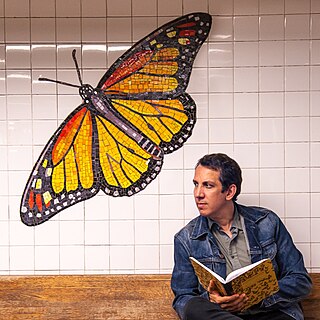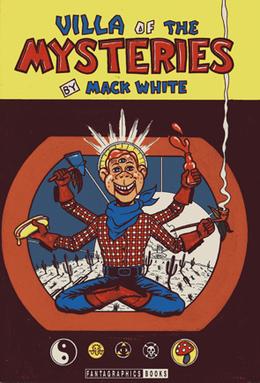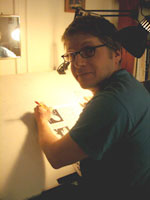
Colleen Doran is an American writer-artist and cartoonist. She illustrated hundreds of comics, graphic novels, books and magazines, including the autobiographical graphic novel of Marvel Comics editor and writer Stan Lee entitled Amazing Fantastic Incredible Stan Lee, which became a New York Times bestseller. She adapted and did the art for the short story "Troll Bridge" by Neil Gaiman, which also became a New York Times bestseller. Her books have received Eisner, Harvey, Bram Stoker, Locus, and International Horror Guild Awards.
An autobiographical comic is an autobiography in the form of comic books or comic strips. The form first became popular in the underground comix movement and has since become more widespread. It is currently most popular in Canadian, American and French comics; all artists listed below are from the U.S. unless otherwise specified.

Drawn & Quarterly is a publishing company based in Montreal, Quebec, Canada, specializing in comics. It publishes primarily comic books, graphic novels and comic strip collections. The books it publishes are noted for their artistic content, as well as the quality of printing and design. The name of the company is a pun on "drawing", "quarterly", and the practice of hanging, drawing and quartering. Initially it specialized in underground and alternative comics, but has since expanded into classic reprints and translations of foreign works. Drawn & Quarterly was the company's flagship quarterly anthology during the 1990s.
Eric Drooker is an American painter, graphic novelist, and frequent cover artist for The New Yorker. He conceived and designed the animation for the film Howl (2010).

Peter Kuper is an American alternative comics artist and illustrator, best known for his autobiographical, political, and social observations.

Phil Jimenez is an American comics artist and writer known for his work as writer/artist on Wonder Woman from 2000 to 2003, as one of the five pencilers of the 2005–2006 miniseries Infinite Crisis, his collaborations with writer Grant Morrison on New X-Men and The Invisibles, and his artistry for his 2021 critically acclaimed partnership with writer Kelly Sue DeConnick on Wonder Woman Historia: The Amazons.
Malachy Coney is a comics writer and cartoonist from Belfast, Northern Ireland. He grew up in Ardoyne in the north of the city.

Mack White is a comics writer and artist who lives in Texas.
Seth Tobocman is a radical comic book artist who has resided in Manhattan's Lower East Side since 1978. Tobocman is best known for his creation of the political comic book anthology World War 3 Illustrated, which he started in 1979 with fellow artist Peter Kuper. Throughout his career, he has played a significant role as a propagandist for various movements in the United States, including squatting, anti-globalization, and anti-war causes. Tobocman's "Edith In Flames. World War 3 Illustrated #45" was listed under "Notable Comics" in The Best American Comics 2015.

Josh Neufeld is an alternative cartoonist known for his comics journalism work on subjects like graphic medicine, equity, and technology; as well as his collaborations with writers like Harvey Pekar and Brooke Gladstone. He is the writer/artist of A.D.: New Orleans After the Deluge, and the illustrator of The Influencing Machine: Brooke Gladstone on the Media.

Australian comics have been published since 1908 and Australian comics creators have gone to produce influential work in the global comics industry,

Sandy Jimenez is an American comic book artist, writer and director, most commonly associated with the New York city independent comic book scene of the 1990s, with work appearing in magazines such as Inner City Press and World War 3 Illustrated.

Noah Van Sciver is an independent American cartoonist who resides in Columbia, South Carolina.
Sabrina Jones is an American painter and comic book artist, writer, illustrator, and editor. In addition to her own graphic novels, she is associated with artist/activist collectives such as Carnival Knowledge and underground comics such as GirlTalk and World War 3 Illustrated.

Comics journalism is a form of journalism that covers news or nonfiction events using the framework of comics, a combination of words and drawn images. Typically, sources are actual people featured in each story, and word balloons are actual quotes. The term "comics journalism" was coined by one of its most notable practitioners, Joe Sacco. Other terms for the practice include "graphic journalism," "comic strip journalism", "cartoon journalism", "cartoon reporting", "comics reportage", "journalistic comics", and "sketchbook reports".
Leonard Rifas is an American cartoonist, critic, editor, and publisher associated with underground comix, comics journalism, left-wing politics, and the anti-nuclear movement. He is notable for his contributions to the form of minicomics as well as publishing Japanese manga in the United States. Rifas' publishing company, EduComics, operated most actively from 1976 to 1982.

The wordless novel is a narrative genre that uses sequences of captionless pictures to tell a story. As artists have often made such books using woodcut and other relief printing techniques, the terms woodcut novel or novel in woodcuts are also used. The genre flourished primarily in the 1920s and 1930s and was most popular in Germany.

Idaho Comics Group (ICG) is an independent comic book publishing company from Boise, Idaho, that was founded in 2014, which publishes the officially licensed Tarzan and the Comics of Idaho anthology and Idaho Comics. The anthologies benefit the Boise Public Library and to bring attention to comic book writers and artists from the state of Idaho.
Angela Bocage is a bisexual comics creator who published mainly in the 1980s and 1990s. Bocage was active in the queer comics community during these decades, publishing in collections like Gay Comix,Strip AIDS USA, and Wimmen's Comix. Bocage also created, edited, and contributed comics to Real Girl, a comics anthology published by Fantagraphics.










